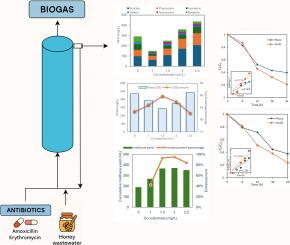Enhanced antibiotic removal by anaerobic co-digestion in an Expanded Granular Sludge Bed (EGSB) reactor treating real pharmaceutical wastewater: From lab-scale to pilot-plant application
Q1 Environmental Science
引用次数: 0
Abstract
Antibiotics are becoming one of the most detected pollutants in water and wastewater, indicating a risk to both the aquatic ecosystem and human health. In this study, a highly biodegradable honey wastewater (HWW) was used as a co-substrate and supplemented in an expanded granular sludge bed (EGSB) reactor to enhance the treatment of real pharmaceutical wastewater containing amoxicillin (AMX) and erythromycin (ERY). The results showed a significant improvement in AMX and ERY removal, increasing from 60 % and 68 % to 78 % and 72 %, respectively, with enhanced reaction rate constants (k) of 0.27 and 0.24. Similarly, COD removal was markedly improved from 83 % to 89 %, while methane yield increased by 42.11 % in anaerobic co-digestion (AcoD) compared to monodigestion. Despite the advantages of HWW, overly high organic loading (2.5 mL/L) resulted in an unstable system, as indicated by the TVFA/alkalinity ratio of 0.87 ± 0.08, due to propionate accumulation. The application in a pilot-scale system demonstrated satisfactory performance, with effluent quality meeting the standards set by local regulations. This study demonstrates the potential of AcoD using highly biodegradable wastewater as a feasible and economical process, with an operational cost of 0.18 USD/m3, which is significantly lower than that of a complex system.

在膨胀颗粒污泥床(EGSB)反应器中厌氧共消化处理实际制药废水:从实验室规模到中试工厂应用
抗生素正在成为水和废水中检测最多的污染物之一,表明对水生生态系统和人类健康都有风险。本研究以高度可生物降解的蜂蜜废水(HWW)作为共底物,并在膨胀颗粒污泥床(EGSB)反应器中进行补充,以增强对含阿莫西林(AMX)和红霉素(ERY)的真实制药废水的处理。结果表明,AMX和ERY的去除率显著提高,分别从60%和68%提高到78%和72%,反应速率常数(k)提高到0.27和0.24。同样,与单消化相比,厌氧共消化(AcoD)的COD去除率从83%显著提高到89%,甲烷产量提高42.11%。尽管HWW具有优势,但过高的有机负荷(2.5 mL/L)导致系统不稳定,TVFA/碱度比为0.87±0.08,这是由于丙酸积累。在中试系统的应用表明了令人满意的性能,出水质量达到了当地规定的标准。本研究表明,利用高可生物降解废水进行AcoD是一种可行且经济的工艺,其运行成本为0.18美元/立方米,明显低于复杂系统的运行成本。
本文章由计算机程序翻译,如有差异,请以英文原文为准。
求助全文
约1分钟内获得全文
求助全文
来源期刊

Bioresource Technology Reports
Environmental Science-Environmental Engineering
CiteScore
7.20
自引率
0.00%
发文量
390
审稿时长
28 days
 求助内容:
求助内容: 应助结果提醒方式:
应助结果提醒方式:


